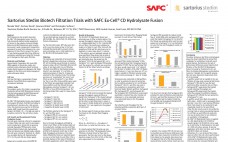Fed-batch and perfusion culture are two dominant modes of operation for mammalian-cell-culture based processes. Challenges in the industry (such as competitive products for the same indication or desired cost reductions) are forcing many to explore new production options. Increasingly popular is the application of the ATF™ System to generate ultra high viable cell concentrations (>100m cells/ml) for a “concentrated” or “intensified” process. The use of the ATF System in a typical concentrated fed-batch process is shown which has generated a…
Expression Platforms
Sartorius Stedim Biotech Filtration Trials with SAFC Ex-Cell Hydrolysate Fusion
SAFC has launched EX-CELL® CD Hydrolysate Fusion, the first fully chemically defined media supplement of its kind in the industry. Sartorius Stedim Biotech and SAFC Biosciences have recently announced a wide-ranging joint cooperation agreement to serve their customers. As a consequence of this effort, a range of 0.2 ÎĽm & 0.1 ÎĽm sterilizing grade filters from different membrane materials were tested for throughput & biological activity post-filtration. This paper provides an insight into superior total throughput performance of the Sartorius…
Modeling Bioprocess Cost
At every stage of biopharmaceutical development, efficient and cost-effective protein production is critically important to maintaining the economic viability of both a product and the company developing it. Biopharmaceuticals have significantly evolved through recent protein engineering advances, resulting in highly complex, novel proteins dominating the development pipeline. Such proteins are by definition very difficult to express in a soluble and active form. The success of these products depends on accessing a platform that rapidly produces high-quality, properly folded,…
Putting It All into Perspective
As part of The Automation Partnership’s “20 Years of Automated Cell Culture” series, science writer Sue Pearson interviewed Dr. John Birch, the chief scientific officer of biopharmaceuticals for Lonza Custom Manufacturing APIS based in Slough, UK. Birch has been with that company since 1996, Before that, he held senior technical positions at Tate and Lyle, GD Searle, and Celltech. Birch has a PhD in microbiology from London University, where he also spent a period lecturing before moving into…
Maintaining Product Titer While Replacing Undefined Components in a CHO Culture System
Proteins, hydrolysates, and lysates of plant or yeast origin are commonly used in cell culture media for large-scale manufacturing processes for human biotherapeutics. Lot-to-lot variability in the composition of such constituents is well established and can affect multiple biological performance indicators. Our goal was to replace an undefined, protein-containing medium with a chemically defined medium (meaning the chemical structure and concentration for each component in a formulation is known). Such a formulation should be free of protein and…
Monitoring ATP Status in the Metabolism of Production Cell Lines
Development of industrial cell culture processes for production of recombinant proteins seeks high efficiency, reproducibility, and predictability. Usually the time allowed for process development is short, during which culture conditions and scale-up protocols must be defined so as to maximize cell productivity and yield while minimizing process scope and overall costs (1). Although scientific literature describes various methods that increase productivity of a cell culture by reducing and arresting cell growth or weakening cell physiology (2), the cells must be…
Comparing Mammalian Expression Systems
Almost every pharmaceutical and biopharmaceutical company in the world depends on the use of recombinant stable cell lines to enable drug discovery, development, and often manufacturing of biologics. It normally falls on multidisciplinary upstream development teams to attain this goal, requiring a wide variety of technologies and skill sets such as laboratory robotics, optical analyzers, molecular biology, and data processing. The large capital investment required to procure the equipment and expertise necessary to develop biologics can be cost prohibitive, which…
An Inoculum Expansion Process for Fragile Recombinant CHO Cell Lines
Development of robust inoculum expansion procedures from cell banks is crucial to successful upstream manufacturing processes. Typically, vial thaw and cell culture expansion processes follow well-established procedures. Certain recombinant cell lines, however, need extra attention and development efforts to optimize conditions for robust and reproducible vial thaw and further subculturing. Difficulties in thawing frozen cells might be clone specific or could originate from suboptimal conditions during freezing. Such conditions might not be known initially and could need further optimization at…
Expression of a Fab Fragment in CHO and Pichia pastoris
Mammalian cell expression systems are currently essential for production of glycosylated biopharmaceuticals such as monoclonal antibodies or molecules requiring even more complex glycan structures. Various host cell and vector systems aimed at improving expression levels and quality have been established (1, 2). Development of biopharmaceutical product candidates from genes to clinical trials should be based on technology platforms that will require no major changes in the entire development chain, including manufacturing once a product candidate has successfully progressed through phase…
A Review of Therapeutic Protein Expression By Mammalian Cells
During the past five years, many biopharmaceuticals have found their way into clinical trials and commercial production (1–4). So far, about 60 million patients worldwide have benefited from these new drugs. The market for biopharmaceuticals was estimated at US$33 billion in 2004 and projected to reach US$70 billion by the end of the decade. During the period 2003–2006, regulators in Europe and the United States approved 32 biopharmaceuticals for human use, including hormones and growth factors, therapeutic enzymes, vaccines, and…


